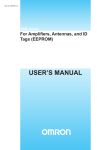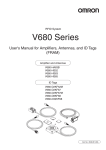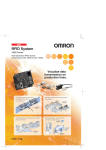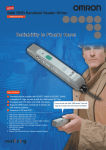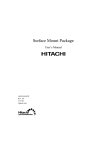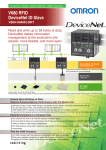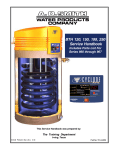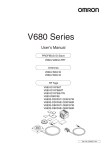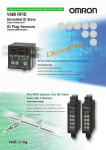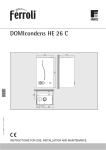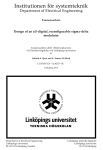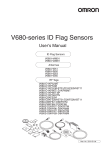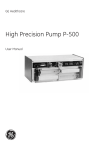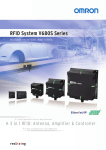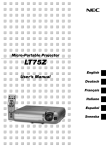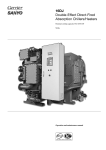Download RFID System V680 Series User`s Manual for Amplifiers
Transcript
Industrial Automation Company Sensing Devices Division H.Q. Industrial Sensors Division Shiokoji Horikawa, Shimogyo-ku, Kyoto, 600-8530 Japan Tel: (81)75-344-7022/Fax: (81)75-344-7107 Regional Headquarters OMRON EUROPE B.V. Sensor Business Unit Carl-Benz-Str. 4, D-71154 Nufringen, Germany Tel: (49) 7032-811-0/Fax: (49) 7032-811-199 OMRON ELECTRONICS LLC One Commerce Drive Schaumburg, IL 60173-5302 U.S.A. Tel: (1) 847-843-7900/Fax: (1) 847-843-7787 RFID System V680 Series User’s Manual for Amplifiers, Antennas, and ID Tags (EEPROM) OMRON Corporation OMRON ASIA PACIFIC PTE. LTD. No. 438A Alexandra Road # 05-05/08 (Lobby 2), Alexandra Technopark, Singapore 119967 Tel: (65) 6835-3011/Fax: (65) 6835-2711 RFID System V680 Series User's Manual for Amplifiers, Antennas, and ID Tags (EEPROM) Amplifier and Antennas V680-HA63A V680-HS51 V680-HS52 V680-HS63 V680-HS65 ID Tags V680-D1KP52MT V680-D1KP66T V680-D1KP66MT V680-D1KP66T-SP OMRON (CHINA) CO., LTD. Room 2211, Bank of China Tower, 200 Yin Cheng Zhong Road, Pu Dong New Area, Shanghai, 200120, China Tel: (86) 21-5037-2222/Fax: (86) 21-5037-2200 In the interest of product improvement, specifications are subject to change without notice. Authorized Distributor: Printed in Japan 1207-0.3C (0507) Z262-E1-03 Cat. No. Z262-E1-03 Cat. No.: Z262-E1-03 Introduction Thank you for purchasing a V680-series RFID System. This manual describes the functions, performance, and application methods needed for optimum use of the V680-series RFID System. Please observe the following items when using the RFID System. • Allow the RFID System to be installed and operated only by qualified specialist with a sufficient knowledge of electrical systems. • Read and understand this manual before attempting to use the RFID System and use the RFID System correctly. • Keep this manual in a safe and accessible location so that it is available for reference when required. READ AND UNDERSTAND THIS DOCUMENT Product Overview Section 2 Specifications and Performance Section 3 Communications Specifications Section 4 Installation Section 5 Chemical Resistance RFID System V680-HA63A V680-HS51 V680-HS52 V680-HS63 V680-HS65 V680-D1KP52MT V680-D1KP66T V680-D1KP66MT V680-D1KP66T-SP Amplifier Antenna Antenna Antenna Antenna ID Tag ID Tag ID Tag ID Tag User's Manual Section 1 Section 2 Section 3 Section 4 Section 5 Section 1 Introduction Introduction Introduction Introduction READ AND UNDERSTAND THIS DOCUMENT Please read and understand this document before using the products. Please consult your OMRON representative if you have any questions or comments. WARRANTY OMRON’s exclusive warranty is that the products are free from defects in materials and workmanship for a period of one year (or other period if specified) from date of sale by OMRON. OMRON MAKES NO WARRANTY OR REPRESENTATION, EXPRESS OR IMPLIED, REGARDING NON-INFRINGEMENT, MERCHANTABILITY, OR FITNESS FOR PARTICULAR PURPOSE OF THE PRODUCTS. ANY BUYER OR USER ACKNOWLEDGES THAT THE BUYER OR USER ALONE HAS DETERMINED THAT THE PRODUCTS WILL SUITABLY MEET THE REQUIREMENTS OF THEIR INTENDED USE. OMRON DISCLAIMS ALL OTHER WARRANTIES, EXPRESS OR IMPLIED. LIMITATIONS OF LIABILITY OMRON SHALL NOT BE RESPONSIBLE FOR SPECIAL, INDIRECT, OR CONSEQUENTIAL DAMAGES, LOSS OF PROFITS OR COMMERCIAL LOSS IN ANY WAY CONNECTED WITH THE PRODUCTS, WHETHER SUCH CLAIM IS BASED ON CONTRACT, WARRANTY, NEGLIGENCE, OR STRICT LIABILITY. In no event shall responsibility of OMRON for any act exceed the individual price of the product on which liability is asserted. IN NO EVENT SHALL OMRON BE RESPONSIBLE FOR WARRANTY, REPAIR, OR OTHER CLAIMS REGARDING THE PRODUCTS UNLESS OMRON’S ANALYSIS CONFIRMS THAT THE PRODUCTS WERE PROPERLY HANDLED, STORED, INSTALLED, AND MAINTAINED AND NOT SUBJECT TO CONTAMINATION, ABUSE, MISUSE, OR INAPPROPRIATE MODIFICATION OR REPAIR. SUITABILITY FOR USE THE PRODUCTS CONTAINED IN THIS DOCUMENT ARE NOT SAFETY RATED. THEY ARE NOT DESIGNED OR RATED FOR ENSURING SAFETY OF PERSONS, AND SHOULD NOT BE RELIED UPON AS A SAFETY COMPONENT OR PROTECTIVE DEVICE FOR SUCH PURPOSES. Please refer to separate catalogs for OMRON's safety rated products. OMRON shall not be responsible for conformity with any standards, codes, or regulations that apply to the combination of products in the customer’s application or use of the product. At the customer’s request, OMRON will provide applicable third party certification documents identifying ratings and limitations of use that apply to the products. This information by itself is not sufficient for a complete determination of the suitability of the products in combination with the end product, machine, system, or other application or use. The following are some examples of applications for which particular attention must be given. This is not intended to be an exhaustive list of all possible uses of the products, nor is it intended to imply that the uses listed may be suitable for the products: • Outdoor use, uses involving potential chemical contamination or electrical interference, or conditions or uses not described in this document. • Nuclear energy control systems, combustion systems, railroad systems, aviation systems, medical equipment, amusement machines, vehicles, safety equipment, and installations subject to separate industry or government regulations. • Systems, machines, and equipment that could present a risk to life or property. Please know and observe all prohibitions of use applicable to the products. NEVER USE THE PRODUCTS FOR AN APPLICATION INVOLVING SERIOUS RISK TO LIFE OR PROPERTY WITHOUT ENSURING THAT THE SYSTEM AS A WHOLE HAS BEEN DESIGNED TO ADDRESS THE RISKS, AND THAT THE OMRON PRODUCT IS PROPERLY RATED AND INSTALLED FOR THE INTENDED USE WITHIN THE OVERALL EQUIPMENT OR SYSTEM. PERFORMANCE DATA Performance data given in this document is provided as a guide for the user in determining suitability and does not constitute a warranty. It may represent the result of OMRON’s test conditions, and the users must correlate it to actual application requirements. Actual performance is subject to the OMRON Warranty and Limitations of Liability. CHANGE IN SPECIFICATIONS Product specifications and accessories may be changed at any time based on improvements and other reasons. It is our practice to change model numbers when published ratings or features are changed, or when significant construction changes are made. However, some specifications of the product may be changed without any notice. When in doubt, special model numbers may be assigned to fix or establish key specifications for your application on your request. Please consult with your OMRON representative at any time to confirm actual specifications of purchased products. DIMENSIONS AND WEIGHTS Dimensions and weights are nominal and are not to be used for manufacturing purposes, even when tolerances are shown. ERRORS AND OMISSIONS The information in this document has been carefully checked and is believed to be accurate; however, no responsibility is assumed for clerical, typographical, or proofreading errors, or omissions. PROGRAMMABLE PRODUCTS OMRON shall not be responsible for the user’s programming of a programmable product, or any consequence thereof. COPYRIGHT AND COPY PERMISSION This document shall not be copied for sales or promotions without permission. This document is protected by copyright and is intended solely for use in conjunction with the product. Please notify us before copying or reproducing this document in any manner, for any other purpose. If copying or transmitting this document to another, please copy or transmit it in its entirety. 2 RFID System User's Manual Introduction Introduction Safety Precautions Alert Symbols for Safe Use The following symbols are used in this manual to indicate precautions that must be observed to ensure safe use of the V680-HS51, V680-HS52, V680-HS63, V680-HS65, V680-HA63A, V680-D1KP52MT, V680D1KP66T, V680-D1KP66MT, and V680-D1KP66T-SP. The precautions provided here contain important safety information. Be sure to observe these precautions. The following signal words are used in this manual. WARNING Indicates a potentially hazardous situation which, if not avoided, will result in minor or moderate injury, or may result in serious injury or death. Additionally, there may be significant property damage. Meanings of Alert Symbols Indicates general prohibitions for which there is no specific symbol. Warning WARNING These Products are not designed to be used either directly or indirectly in applications that detect human presence for the purpose of maintaining safety. Do not use these Products as a sensing means for protecting human lives. Regulations and Standards The Products conform to the following overseas regulations and standards. 1.The United States Amplifier This product complies with Part 15 Subpart C of the FCC Rules. FCC ID: E4E6CYSIDV6800406 Antenna V680-HA63A V680-HS51 V680-HS52 V680-HS63 V680-HS65 FCC NOTICE This device complies with part 15 of the FCC Rules. Operation is subject to the following two conditions: (1) This device may not cause harmful interference. (2) This device must accept any interference received, including interference that may cause undesired operation. FCC WARNING Changes or modifications not expressly approved by the party responsible for compliance could void the user's authority to operate the equipment. Do not remove the ferrite core (TDK Type ZCAT1730-0730A:V680-HS52/-HS63/-HS65, TDK Type ZCAT15250430AP:V680-HS51) installed on the cables to suppress RF interference. RFID System User's Manual 3 Introduction Introduction 2. Europe Amplifier (Radio and Telecommunication Terminal Equipment Directive 1999/5/EC) V680-HA63A Radio: EN 300 330-2V1.3.1 (04-2006) EN 300 330-1V1.5.1 (04-2006) EMC: EN 301 489-3V1.4.1 (08-2002) EN 301 489-1V1.6.1 (09-2005) Safety: EN 61010-1: 2001 (2nd Edition) Antenna V680-HS51 V680-HS52 V680-HS63 V680-HS65 English Hereby, Omron, declares that the RFID System, V680-HS51 Series, V680-HS52 Series, V680-HS63 Series, V680-HS65 Series and V680-HA63A Series are in compliance with the essential requirements and other relevant provisions of Directive 1999/5/EC. Finnish Omron vakuuttaa täten että RFID Säännös, V680-HS51 Series, V680-HS52 Series, V680-HS63 Series V680-HS65 Series,, V680-HA63A Series tyyppinen laite on direktiivin 1999/5/EY oleellisten vaatimusten ja sitä koskevien direktiivin muiden ehtojen mukainen. Dutch Hierbij verklaart Omron dat het toestel de RFID Systeem, V680-HS51 ´Serie, V680-HS52 ´Serie, V680-HS63 ´Serie, V680-HS65 ´Serie, V680-HA63A ´Serie in overeenstemming is met de essentiële eisen en de andere relevante bepalingen van richtlijh 1999/5/EG. French Par la présente Omron déclare que la RFID Système, V680-HS51 Série, V680-HS52 Série, V680-HS63 Série, V680-HS65 Série, V680-HA63A Série sont conforme aux exigences essentielles et aux autres dispositions pertinentes de la directive 1999/5/CE. Swedish Härmed intygar Omron att den RFID System, V680-HS51 Serie, V680-HS52 Serie, V680-HS63 Serie, V680-HS65 Serie, V680-HA63A Serie stär l överensstämmelse med de väsentliga egenskapskrav och övriga relevanta bestämmelser som framgår av direktiv 1999/5/EG. Danish Undertegnede Omron erklærer herved, at følgende den RFID System, V680-HS51 Serie, V680-HS52 Serie, V680-HS63 Serie, V680-HS65 Serie, 680HA63A Serie overholder de væsentlige krav og øvrige relevante krav i direktiv 1999/5/EF. German Hiermit erklärt Omron, die RFID System, V680-HS51 Serie, V680-HS52 Serie, V680-HS63 Serie, V680-HS65 Serie, V680-HA63A Serie in Übereinstimmung mit den grundlegenden Anforderungen und den anderen relevanten Vorschriften der Richtlinie 1999/5/EG befindet. (BMWi) Greek ME THN ΠAPOYSA Omron ΔHΛONEI RFID O’YO’ΓΗΜΑ, V680-HS51 O’EIPA, V680-HS52 O’EIPA, V680-HS63 O’EIPA, V680-HS65 O’EIPA, V680HA63A O’EIPA SYMMOPF ONETAI ΠPOS TIS OYSIOΔEIS AΠAITHSEIS KAI TIS ΛOIΠES SXETIKES ΔIATAΞEIS THS OΔHΓIAS 1999/5/EK. Italian Con la presente Omron dichiara che la RFID Sistema, V680-HS51Serie, V680-HS52Serie, V680-HS63 Serie,V680-HS65 Serie, V680-HA63A Serie sono conforme ai requisiti essenziali ed alle altre disposizioni pertinenti stabilite dalla direttiva 1999/5/CE. Spanish Por medio de la presente Omron declara que el RFID Sistema, V680-HS51 Serie, V680-HS52 Serie, V680-HS63 Serie, V680-HS65 Serie, V680-HA63A Serie esta conforme a los requisitos esenciales y cualesquiera otras disposiciones aplicables o exigibles de la Directiva 1999/5/CE. Portuguese Omron declara que a RFID Sistema, V680-HS51 Série, V680-HS52 Série, V680-HS63 Série, V680-HS65 Série, V680-HA63A Série ser conforme com os tequisitos essenciais e outras disposições da Directiva 1999/5/CE. Romanian Prin prezenta, Omron declar c acest V680-HS51, V680-HS52, V680-HS63, V680-HS65,V680-HA63A este conform cu cerin ele principale çi cu celelalte prevederi relevanate ale Directivei 1999/5/EC. 3. Japan Amplifier Antenna Equipment using high frequencies: Inductive Reading/Writing Communications Equipment V680-HA63A V680-HS51 Conforming standards: Inductive Reading/Writing Communications Equipment; Standard: ARIB STD-T82 V680-HS52 EC-06019 V680-HS63 V680-HS65 4. Canada Amplifier IC ID:850J-V68HA63A V680-HA63A Antenna V680-HS51 V680-HS52 V680-HS63 V680-HS65 This device complies with RSS-Gen of IC Rules. Operation is subject to the following two conditions:(1) this device may not cause harmful interference, and (2) this device must accept any interference received, including interference that may cause undesired operation. 4 RFID System User's Manual Introduction Introduction 5. China Amplifier Antenna CMII ID:2007DJ0577 V680-HA63A V680-HS52-R CMII ID:2007DJ0575 V680-HA63A V680-HS52-W CMII ID:2007DJ0573 V680-HA63A V680-HS63-W CMII ID:2007DJ0571 V680-HA63A V680-HS63-R 6. Korea Amplifier OMR-V680-HA63A V680-HA63A Antenna V680-HS52-R V680-HS52-W V680-HS63-R V680-HS63-W V680-HS65-R V680-HS65-W 7. Taiwan Amplifier CCAB07LP1220T4 V680-HA63A Antenna V680-HS52 V680-HS63 V680-HS65 RFID System User's Manual 5 Introduction Introduction 8. Hong Kong Amplifier LP407043 V680-HA63A Antenna V680-HS52 V680-HS63 9. Singapore Amplifier S0294-07 V680-HA63A Antenna V680-HS52 V680-HS63 V680-HS65 10.Malaysia Amplifier A011579 V680-HA63A Antenna V680-HS52 V680-HS63 V680-HS65 If the product is used in Malaysia, a label must be attached on-site to the side of the V680-HA63A. Please consult your OMRON sales representative for details. 11.Philippine Amplifier ESD-0702996C V680-HA63A Antenna V680-HS52 V680-HS63 V680-HS65 12.Mexico Amplifier COFETEL:RCPOMV607-622 V680-HA63A Antenna V680-HS52 V680-HS63 Este equipo opera a titulo secundario, consecuentemente, debe aceptar interferencias perjudiciales incluyendo equipos de la misma clase y puede no causar interferencias a sistemas operando a titulo primario. 13.Thailand The certification is unnecessary, so the product can be used. Changes or modifications not expressly approved by the party responsible for compliance could void the user's authority to operate the equipment. Do not remove the ferrite core (TDK Type ZCAT1730-0730A:V680-HS52/-HS63/-HS65, TDK Type ZCAT15250430AP:V680-HS51) installed on the cables to suppress RF interference. 6 RFID System User's Manual Introduction Introduction Precautions for Safe Use Be sure to observe the following precautions to ensure safe use of the Products. 1. Do not use the Products in environments with flammable, explosive, or corrosive gasses. 2. Do not attempt to disassemble, repair, or modify any Product. 3. Tighten mounting screws securely. 4. Because a cable has a locking mechanism, make sure that it has been locked before using the cable. 5. Do not allow water or pieces of wire to enter from openings in the case. Doing so may cause fire or electric shock. 6. Turn OFF the Controller power supply before mounting or removing an Antenna or Amplifier. 7. If an error is detected in any Product, immediately stop operation and turn OFF the power supply. Consult with an OMRON representative. 8. Dispose of the Products as industrial waste. 9. Observe all warnings and precautions given in the body of this manual. 10. Do not touch the product immediately after usage at high temperatures. Doing so may occasionally result in burning. RFID System User's Manual 7 Introduction Introduction Precautions for Correct Use Always observe the following precautions to prevent operation failures, malfunctions, and adverse effects on performance and equipment. 1. Installation Environment Do not use the Products in the following locations. • Locations exposed to corrosive gases, dust, metallic powder, or salts • Locations not within the specified operating temperature range • Locations subject to rapid changes in temperature or condensation • Locations not within the specified humidity range • Locations subject to direct vibration or shock outside the specified ranges • Locations subject to spray of water, oil, or chemicals 2. Installation The Products communicate with Tags using the 13.56-MHz frequency band. Some motors, inverters, and switching power supplies generate noise that can affect communications with the Tags and cause errors. If such devices are located near the Tags, always test operation in advance to confirm whether the system will be affected. • Observe the following precautions to minimize the effects of normal noise. (1) Ground all metal objects in the vicinity of the Products to 100 Ω or less. (2) Do not use the Products near high-voltage or high-current lines. • Do not use non-waterproof Products in an environment where mist is present. • Do not expose the Products to chemicals that adversely affect the Product materials. • When mounting the Products, tighten the screws to the following torques. V680-HS51: 6 N⋅m V680-HS52: 40 N⋅m V680-HS63: 1.2 N⋅m V680-HS65: 1.2 N⋅m • Do not pull the Antenna connector over the power of 30 N. The Antenna connector may be broken. • Transmission will not be possible if the front and back panels are mistakenly reversed and the Unit is mounted to a metallic surface. V680-D1KP66MT • The transmission distance will be reduced when the Unit is not mounted to a metallic surface. V680-D1KP66MT • If multiple Antennas are mounted near each other, communications performance may decrease due to mutual interference. Refer to Installing Antennas on page 48 and check to make sure there is no mutual interference. • Depending on the operating environment, the case surface may become fogged, but basic performance will not be affected. 8 RFID System User's Manual Introduction Introduction 3. Storage Do not store the Products in the following locations. • Locations exposed to corrosive gases, dust, metallic powder, or salts • Locations not within the specified storage temperature range • Locations subject to rapid changes in temperature or condensation • Locations not within the specified storage humidity range • Locations subject to direct vibration or shock outside the specified ranges • Locations subject to spray of water, oil, or chemicals 4. Cleaning • Do not clean the Products with paint thinner or the equivalent. Paint thinner or the equivalent will dissolve the resin materials and case coating. 5. Combination of the Amplifier • Use the V680-D1KP52MT, V680-D1KP66T, V680-D1KP66MT, and V680-D1KP66T-SP ID Tags in combination with only the V680-HA63A Amplifier. Do not use these ID Tags together with the V680HA63B Amplifier. RFID System User's Manual 9 Introduction Introduction Meanings of Symbols 10 Meanings of Symbols Indicates particularly important points related to a function, including precautions and application advice. Indicates page numbers containing relevant information. RFID System User's Manual Introduction Introduction Table of Contents Safety Precautions 3 Regulations and Standards 3 Precautions for Safe Use 7 Precautions for Correct Use 8 Meanings of Symbols 10 Table of Contents 11 Section 1 Product Overview 13 Features 14 Product Configuration 15 Section 2 Specifications and Performance 17 Antennas with Separate Amplifier 18 Amplifier 25 Tags 28 Section 3 Communications Specifications 35 Communications Distances 36 Communication Time (Reference) 44 Section 4 Installation 47 Installing Antennas 48 Mounting Amplifiers 54 Installing Tags 56 Section 5 Chemical Resistance 65 Chemical Resistance of the Antennas 66 Chemical Resistance of Tags 67 Degree of Protection 72 Revision History 74 RFID System User's Manual 11 Introduction Introduction 12 MEMO RFID System User's Manual Section 1 Section 1 Product Overview 14 Product Configuration 15 RFID System User's Manual Product Overview Features 13 Section 1 Product Overview Features The V680-series RFID System actively supports many different types of system, such as distributed-control Section 1 Features systems and many-product, small-lot production systems, with non-contact data communications using electromagnetic induction. Non-contact Data Communications The V680 Series uses electromagnetic induction to enable non-contact, bi-directional data communications between Antennas and Tags. EEPROM Memory EEPROM (non-volatile memory) is used for Tag memory. No battery is required, so there is no need to be concerned about battery service life. CRC Used for Transmission Error Detection A bi-directional 16-bit CRC (Cyclic Redundancy Check) has been added as the error detection method for wire transmissions between ID Controllers and Antennas, and for wireless transmissions between Antennas and Tags. This method maintains superior communications reliability even where problems such as noise occur. 1,000byte of Memory Tags have 1,000byte of memory. In addition to the ID data required on-site, data such as model numbers and inspection information can be input. Long Service Life of 100,000 Data Rewrites at Normal Temperatures When the Tag is used at temperatures of up to 25°C, each block of EEPROM data can be rewritten up to 100,000 times. Superior Environmental Resistance and High Reliability Antennas and Tags now have greater environmental resistance and are not affected by vibration, oil, or water (in units of single, 8-byte blocks). 14 RFID System User's Manual Section 1 Product Overview Product Configuration A V680-series RFID System consists of an ID Controller, one or more Amplifiers, one or two Antennas, and Section 1 Product Configuration Tags. Select the models suitable for the application. RS-232C RS-422 RS-485 CS1W-V680C11/12 V680-CA5D02-V2 ID Controller ID Sensor Units V680-CA5D01-V2 Programmable Controller (SYSMAC CS/CJ Series) Programmable Controller (PLC) Host device Personal computer V68 0C1 RUN1 ERC NOR CJ1W-V680C11/12 V68 ERP ERH T/R M/ER R 0C1 RUN2 ERC HEA D1 T/R ERP ERH HEA T/R D2 NOR M/ER R NOR M/ER R TES T TES T ON ON HEA D1 HEA D1 DC2 INP 4V UT HEA D2 + - Antennas with Separate Amplifier Amplifiers V680-HA63A V680-HS51 V680-HS63 V680-D1KP66T V680-D1KP66MT V680-HS65 V680-D1KP66T-SP Tags V680-D1KP52MT V680-HS52 When embedding the V680-D1KP52MT into a metal surface, use the V680-HS51, V680-HS52 Antenna. Transmission will not be possible if the V680-HS63 Antenna is used. Use the V680-D1KP52MT, V680-D1KP66T, V680-D1KP66MT, and V680-D1KP66T-SP ID Tags in combination with only the V680-HA63A Amplifier, Do not use these ID Tags together with the V680-HA63B Amplifier. RFID System User's Manual 15 Section 1 Product Overview MEMO Section 1 Product Configuration 16 RFID System User's Manual Section 2 Specifications and Performance Section 2 18 Amplifier 25 Tags 28 RFID System User's Manual Specifications and Performance Antennas with Separate Amplifier 17 Section 2 Specifications and Performance Antennas with Separate Amplifier V680-HS51 General Specifications Item Model V680-HS51 Section 2 Antennas with Separate Amplifier Ambient operating temperature −10 to 60°C (with no icing) Ambient storage temperature −25 to 75°C (with no icing) Ambient operating humidity 35% to 95% (with no condensation) Insulation resistance 20 MΩ min. (at 500 VDC) between connector terminals and case Dielectric strength 1,000 VAC, 50/60 Hz for 1 min between connector terminals and case Degree of protection IP67.(IEC60529) In-house standard for antenna oil resistance (former JEM standard equivalent to IP67g) Note: The connectors are not waterproof. Dielectric strength 10 to 2,000 Hz, 1.5-mm double amplitude, acceleration: 150 m/s2, 10 sweeps in each of 3 axis directions (up/down, left/right, and forward/backward) for 15 minutes each Shock resistance 1,000 m/s2, 3 times each in 6 directions (Total: 18 times) Dimensions M12 × 35 mm Material ABS resin, brass, and epoxy resin filler Weight Approx. 55 g Cable length Standard lengths of 2 m Dimensions • V680-HS51 12.5 (Unit : mm) dia. Toothed washer 26.2 12 M12 × 1 Connector Ferrite core Two lock nuts Mounting Hole Dimensions . 24 33 35 Coaxial cable, 2.9 dia., standard length: 2 m (16.8 dia.) 50 25 7 (14.5 dia.) 17 9.6 dia. 21 dia 15 Insulation cover 18 RFID System User's Manual Case material Brass Communications surface ABS resin Fill resin Epoxy resin Cable PVC (black) Section 2 Specifications and Performance V680-HS52 General Specifications Item Model V680-HS52-W (Standard cable, waterproof connector) −10 to 60°C (with no icing) Ambient storage temperature −25 to 75°C (with no icing) Ambient operating humidity 35% to 95% (with no condensation) Insulation resistance 20 MΩ min. (at 500 VDC) between connector terminals and case Dielectric strength 1,000 VAC, 50/60 Hz for 1 min between connector terminals and case Degree of protection IP67.(IEC60529) In-house standard for antenna oil resistance (former JEM standard equivalent to IP67g) Note: The connector specifications are IP67 and IP65.(IEC60529) Dielectric strength 10 to 500 Hz, 1.5-mm double amplitude, acceleration: 100 m/s2, 10 sweeps in each of 3 axis directions (up/down, left/right, and forward/backward) for 8 minutes each Section 2 Antennas with Separate Amplifier Ambient operating temperature V680-HS52-R (Flexible cable, non-waterproof connector) IP67.(IEC60529) In-house standard for antenna oil resistance (former JEM standard equivalent to IP67g) Note: The connectors are not waterproof. Shock resistance 500 m/s2, 3 times each in 6 directions (Total: 18 times) Dimensions M22 × 65 mm Material ABS resin, brass, and epoxy resin filler Weight Approx. 850 g (with 12.5 m cable) Cable length Standard lengths of 2 and 12.5 m Dimensions • V680-HS52-W 22.5 dia. Two toothed washers Two lock nuts Mounting Hole Dimensions M22 × 1 Ferrite core Operation indicator 37 16.5 dia. 30 Connector 14.5 dia. 19.8 dia. 35 dia. 7 30 47.6 50 57 65 16.5 dia. Antenna 50 Insulation cover Coaxial cable, 5.5 dia., standard length: 2 m Case material Brass Communications surface ABS resin Fill resin Epoxy resin Cable PVC (gray) RFID System User's Manual 19 Section 2 Specifications and Performance • V680-HS52-R 22.5 dia. Two toothed washers Two lock nuts Mounting Hole Dimensions (39.5) 35 dia. 30 14.5 dia. 16.5 dia. 7 30 47.6 50 57 65 RFID System User's Manual Insulation cover Connector 16.5 dia. Ferrite core Operation indicator Antenna 19.8 dia. Section 2 Antennas with Separate Amplifier 20 M22 × 1 50 Coaxial cable, 5.3 dia., standard length: 2 m Insulation cover Case material Brass Communications surface ABS resin Fill resin Epoxy resin Cable PVC (black) Section 2 Specifications and Performance V680-HS63 General Specifications Item Model V680-HS63-W (Standard cable, waterproof connector) V680-HS63-R (Flexible cable, non-waterproof connector) −10 to 60°C (with no icing) Ambient storage temperature −25 to 75°C (with no icing) Ambient operating humidity 35% to 95% (with no condensation) Insulation resistance 20 MΩ min. (at 500 VDC) between cable terminals and case Dielectric strength 1,000 VAC, 50/60Hz for 1 min between cable terminals and case Degree of protection IP67.(IEC60529) In-house standard for antenna oil resistance (former JEM standard equivalent to IP67g) Note: The connector specifications are IP67 and IP65.(IEC60529) Vibration resistance 10 to 500 Hz, 1.5-mm double amplitude, acceleration: 100 m/s2, 10 sweeps in each of 3 axis directions (up/down, left/right, and forward/backward) for 11 minutes each Shock resistance 500 m/s2, 3 times each in 6 directions (Total: 18 times) Dimensions 40 × 53 × 23 mm Material ABS resin case, epoxy resin filler Weight Approx. 850 g (with 12.5 m cable) Cable length Standard lengths of 2 and 12.5 m Section 2 Antennas with Separate Amplifier Ambient operating temperature IP67.(IEC60529) In-house standard for antenna oil resistance (former JEM standard equivalent to IP67g) Note: The connectors are not waterproof. Dimensions • V680-HS63-W Antenna (Unit: mm) Ferrite core 6 30 53 16.5 dia. 14.5 dia. 27 5 16.5 dia. 40 28±0.1 5 37 Connector 50 Insulation cover Coaxial cable, 5.5 dia., standard length: 2 m 11 23 Operation indicator Note: Mounting Hole Dimensions Two, M4 or 4.5 dia. holes Coil center Case material ABS resin Fill resin Epoxy resin Cable PVC (gray) RFID System User's Manual 21 Section 2 Specifications and Performance V680-HS63-R Antenna Ferrite core 6 30 53 RFID System User's Manual 50 Coaxial cable, 5.3 dia., standard length: 2 m Insulation cover 11 Operation indicator Note: Mounting Hole Dimensions Coil center 16.5 dia. 16.5 dia. 14.5 dia. 40 28±0.1 27 5 23 Section 2 Antennas with Separate Amplifier 22 5 (39.5) (Unit: mm) Connector Two, M4 or 4.5 dia. holes Case material ABS resin Fill resin Epoxy resin Cable PVC (black) Section 2 Specifications and Performance V680-HS65 General Specifications Item Model V680-HS65-W (Standard cable, waterproof connector) V680-HS65-R (Flexible cable, non-waterproof connector) −25 to 70°C (with no icing) Ambient storage temperature −40 to 85°C (with no icing) Ambient operating humidity 35% to 95% (with no condensation) Insulation resistance 20 MΩ min. (at 500 VDC) between connector terminals and case Dielectric strength 1,000 VAC, 50/60 Hz for 1 min between connector terminals and case Degree of protection IP67 (IEC60529) In-house standard for antenna oil resistance (former JEM standard equivalent to IP67g) Note: The connector specifications are IP67 and IP65 (IEC 60529). Dielectric strength 10 to 500 Hz, 1.5-mm double amplitude, acceleration: 100 m/s2, 10 sweeps in each of 3 axis directions Section 2 Antennas with Separate Amplifier Ambient operating temperature IP67 (IEC60529) In-house standard for antenna oil resistance (former JEM standard equivalent to IP67g) Note: The connectors are not waterproof. (up/down, left/right, and forward/backward) for 11 minutes each Shock resistance 500 m/s2, 3 times each in 6 directions (Total: 18 times) Dimensions 100 × 100 × 30 mm Material ABS resin case, epoxy resin filler Weight Approx. 1100 g (with 12.5 m cable) Cable length Standard lengths of 2 and 12.5 m Dimensions • V680-HS65-W 5 4-4.5 dia. (Mounting holes) 50 5 Operation indicator (Unit: mm) 100 90±0.2 Ferrite core Connector 50 37 16.5 dia. 16.5 dia. 100 90±0.2 14.5 dia. 25 Bushing 30 10 50 10 20 30 14 Coaxial cable, 5.5 dia., standard length: 2 m Insulation cover 11 Case material ABS resin Fill resin Epoxy resin Cable PVC (gray) RFID System User's Manual 23 Section 2 Specifications and Performance V680-HS65-R 5 4-4.5 dia. (Mounting holes) 50 5 Operation indicator (Unit: mm) 100 90±0.2 Ferrite core 50 Bushing 30 10 20 30 User's Manual 50 10 14 RFID System 16.5 dia. 14.5 dia. 16.5 dia. 100 90±0.2 Section 2 Antennas with Separate Amplifier 24 Connector (39.5) 25 Coaxial cable, 5.3 dia., standard length: 2 m Insulation cover 11 Case material ABS resin Fill resin Epoxy resin Cable PVC (black) Section 2 Specifications and Performance Amplifier V680-HA63A General Specifications Item Model V680-HA63A −10 to 55°C (with no icing) Ambient storage temperature −25 to 65°C (with no icing) Ambient operating humidity 35% to 85% (with no condensation) Insulation resistance 20 MΩ min. (at 500 VDC) between cable terminals and case Dielectric strength 1,000 VAC, 50/60 Hz for 1 minute between cable terminals and case. Degree of protection IP67, IP65 (IEC 60529) Note: Not including connector at Controller end. (When V680-HS52-W, V680-HS63-W, and V680-HS65-W is connected) Dielectric strength 10 to 500 Hz, 1.5-mm double amplitude, acceleration:100 m/s2, 10 sweeps in each of 3 axis directions (up/down, left/right, and forward/backward) for 11 minutes each Shock resistance 500 m/s2, 3 times each in 6 directions (Total: 18 times) Dimensions 25 × 40 × 65 mm (Not including protrusions.) Materials PC Weight Approx. 650 g (with 10 m cable) Cable length Standard lengths of 5 and 10 m Section 2 Amplifier Ambient operating temperature IP40 (IEC 60529) (When V680-HS51, V680-HS52-R, V680HS63-R, and V680-HS65-R is connected) Note: The maximum total cable extension is 50 m (including the Amplifier cable). A maximum of two extension cables can be connected. Dimensions 65 18 25 40 25 9.5 dia. Connector 36 35.6 3.5 Connector 15 25 51 15 dia. 13.7 12.8 dia. Operation indicator Round, vinyl-insulated cable (5.8 dia.), standard length: 5 m, (41/0.16 dia) 2 conductors, (17/0.08 dia.) 8 conductors Case material PC resin Cable PVC RFID System User's Manual 25 Section 2 Specifications and Performance Nomenclature Antenna connection port Section 2 Amplifier RUN COMM NORM ERR Operation indicators LV6/7D LV5/7A LV4/76 LV3/72 LV2/71 LV1/70 Controller connector Antenna Connection Port The Antenna connection port is connected a V680-series Antenna. Controller Connector The Controller connector is connected to Antenna connection port on the Controller. Operation Indicators (LEDs) Name Color RUN Green Lit when the power is ON. COMM NORM Yellow Meaning Lit when a command is being sent. Green Lit when communications with a Tag are normal in Normal Communications Mode. ERR Red Lit when an error occurs in communications with a Tag in Normal Communications Mode. LV6/7D Yellow Maintenance Mode: Lit at distance or speed level 6. Normal Communications Mode: Lit when a write protection error occurs. LV5/7A Yellow Maintenance Mode: Lit at distance or speed level 5 or higher. Normal Communications Mode: Lit when an address error occurs. LV4/76 Yellow Maintenance Mode: Lit at distance or speed level 4 or higher. Normal Communications Mode: Lit when a Tag memory error occurs. LV3/72 Yellow Maintenance Mode: Lit at distance or speed level 3 or higher. Normal Communications Mode: Lit when a no Tag error occurs. LV2/71 Yellow Maintenance Mode: Lit at distance or speed level 2 or higher. Normal Communications Mode: Lit when a verification error occurs. LV1/70 Yellow Maintenance Mode: Lit at distance or speed level 1 or higher. Normal Communications Mode: Lit when a Tag communications error occurs. The distance level will vary greatly depending on the surrounding environment. The setting position will serve as a guide, but use RUN mode to conduct a sufficient number of tests in the actual operating environment. Values of distance level 4 or above may not be displayed, but this will not affect the RUN mode performance and does not indicate a malfunction. 26 RFID System User's Manual Section 2 Specifications and Performance Cables Specifications Item Model V700-A43/V700-A44 Number of conductors 10 Insulation resistance 5 MΩ min. (at 500 VDC) between terminals and sheath Dielectric strength 500 VAC, 1 min Section 2 Amplifier Dimensions Model Length (L1) Weight V700-A43 V700-A44 Approx.10m Approx. 20 m Approx. 700 g Approx.1,350 g L1±100 49 6 dia. 15 dia. 51 15.5 dia. Item Connector (Amplifier end) Connector (Controller end)) Connection label (Unit: mm) Casing material PVC RFID System User's Manual 27 Section 2 Specifications and Performance Tags Specifications and Dimensions V680-D1KP52MT • General Specifications Section 2 Tags Item Model V680-D1KP52MT Memory capacity 1,000 bytes (user area) Memory type EEPROM Data backup time 10 years after writing (85°C or less), 0.5 years after writing (85°C to 125°C) Total data backup time at high temperatures exceeding 125°C is 10 houres (See note.) Memory longevity 100,000 times per block (25°C) Ambient operating temperature when communicating −25 to 85°C (with no icing) Ambient operating temperature when not communicating −40 to125°C (with no icing) Ambient storage temperature −40 to 125°C (with no icing) Ambient operating humidity 35% to 95% Degree of protection IP68 (IEC 60529) In-house standard for antenna oil resistance (former JEM standard equivalent to IP67g) Vibration resistance 10 to 2,000 Hz, 1.5-mm double amplitude, acceleration: 150 m/s2, 10 sweeps each in X, Y, and Z directions for 15 minutes each Shock resistance 500 m/s2, 3 times each in X, Y, and Z directions (Total: 18 times) Dimensions 8 dia. × 5 mm Materials Case: PPS resin, Fill resin: Epoxy resin Weight Approx. 0.5 g Metal countermeasures Yes Note: After string data at high temperatures, rewrite the data even if changes are not required, In this manual, high temperatures are those exceeding 125°C up to 180°C. • Dimensions R0.2 0 8 −0.1 dia. 0 5 −0.1 (Unit : mm) Case material PPS resin Fill resin Epoxy resin When embedding the V680-D1KP52MT into a metal surface, use the V680-HS51, V680-HS52 Antenna. Transmission will not be possible if the V680-HS63 Antenna is used. The side with the markings is the communications surface. Mount the Tag with this side facing the Antenna. The ID code is written in the memory of the Tag and may be affected by data retention characteristics at high temperatures. Take suitable precautions when using the READ ID command for Tags operating at high temperatures. 28 RFID System User's Manual Section 2 Specifications and Performance V680-D1KP66T/66MT • General Specifications Item Model V680-D1KP66T V680-D1KP66MT 1,000 bytes (user area) Memory type EEPROM Data backup time 10 years after writing (85°C or less), 0.5 years after writing (85°C to 125°C) Total data backup time at high temperatures exceeding 125°C is 10 houres (See note.) Memory longevity Section 2 Tags Memory capacity 100,000 times per block (25°C) −25 to 85°C (with no icing) Ambient operating temperature when communicating Ambient operating temperature when not communicating −40 to125°C (with no icing) Ambient storage temperature −40 to 125°C (with no icing) Ambient operating humidity 35% to 95% Degree of protection IP68 (IEC 60529) In-house standard for antenna oil resistance (former JEM standard equivalent to IP67g) Vibration resistance 10 to 2,000 Hz, 1.5-mm double amplitude, acceleration: 150 m/s2,10 sweeps each in X, Y, and Z directions for 15 minutes each Shock resistance 500 m/s2, 3 times each in X, Y, and Z directions (Total: 18 times) Dimensions 34 × 34 × 3.5 mm Materials Case: PPS resin Weight Approx. 6 g Approx. 7.5 g Metal countermeasures None Yes Note: After string data at high temperatures, rewrite the data even if changes are not required, In this manual, high temperatures are those exceeding 125°C up to 180°C. The V680-D1KP66MT is designed to be mounted directly to metal. The V680-D1KP66T and V680D1KP66MT markings are shown in the following diagrams. V680-D1KP66MT V680-D1KP66MT V680-D1KP66T V680-D1KP66T XXXXXX XXXXXX MADE IN JAPAN MADE IN JAPAN The side with the markings is the communications surface. Mount the Tag with this side facing the Antenna. The ID code is written in the memory of the Tag and may be affected by data retention characteristics at high temperatures. Take suitable precautions when using the READ ID command for Tags operating at high temperatures. RFID System User's Manual 29 Section 2 Specifications and Performance • Dimensions V680-D1KP66T/66MT Four, R4 34 Four, R3 25+0.2 32 Mounting Hole Dimensions 25+0.2 Two, M3 25+0.2 Section 2 Tags Two, 3.5 dia. Two, 6 dia. 32 25+0.2 3.5+0.1 34 Case material PPS resin V600-A86 Attachment Four, R5.5 25+0.2 Two, 4 dia. Two, M3 37 34 15 25+0.2 16 25+0.2 25+0.2 15 34 4 3.5 37 10 Case material PPS resin Tag Heat Resistivity • Storing Tags under high temperatures will adversely affect the performance of the internal parts and the service life of the Tags. • An LTPD of 10% was determined during the evaluation for Tags that reached the end of their life after testing under the following test conditions. Heat cycle −10°C/+150°C, 30 minutes each for 1,000 cycles −100°C/+180°C,30 minutes each for 200 cycles High temperatures +150°C, 1,000 hours +180°C, 200 hours LTPD: Lot tolerance percent defective The lower limit of the malfunction rate for lots to be considered unacceptable during reliability testing. 30 RFID System User's Manual Section 2 Specifications and Performance V680-D1KP66T-SP • General Specifications Item Model V680-D1KP66T-SP 1,000 bytes (user area) Memory type EEPROM Data backup time 10 years after writing (85°C or less) Memory longevity 100,000 times per block (25°C) Section 2 Tags Memory capacity −25 to 70°C (with no icing) Ambient operating temperature when communicating Ambient operating temperature when not communicating −40 to110°C (with no icing) Ambient storage temperature −40 to 110°C (with no icing) Ambient operating humidity 35% to 95% Degree of protection IP67 Vibration resistance 10 to 2,000 Hz, 1.5-mm double amplitude, acceleration: 150 m/s2,10 sweeps each in X, Y, and Z directions for 15 minutes each Shock resistance 500 m/s2, 3 times each in X, Y, and Z directions (Total: 18 times) Dimensions 95 × 36.5 × 6.5 mm (excluding protruding parts) Materials External coatiog: Fluororesin (PFA) Tag body: PPS resin Weight Approx. 20 g Mounting method Two M5 screws Metal countermeasures None • Dimensions Four, R6 34 Two, 5.5 dia. (Mounting hole) (Unit: mm) Mounting Hole Dimensions Two, M5 36.5 34 80±0.2 1.3 6.5 2.5 max. 80±0.2 Case material PFA resin 95 The side with the markings is the communications surface. Mount the Tag with this side facing the Antenna. RFID System User's Manual 31 Section 2 Specifications and Performance Memory Map Data Address Section 2 Tags 0000 0001 H 0002 H 0003 H 03E6 H 03E7 H H User area 1 byte EEPROM is used as memory in the Tags. The memory capacity available to the user is 1,000 bytes, including 0000H to 0003H (the Write Protection Setting Area). The access to the memory is executed at every block. 1 block is 8 bytes (8 addresses). 32 RFID System User's Manual Section 2 Specifications and Performance Write Protection Function The write protection function prevents important data, such as product information, stored in memory in a Tag from being inadvertently overwritten. After important data has been written to memory, it can be write-protected using the following method. The write protect function setting can be switched with switches 4 to 7 (Write Protect Function Setting) of the V680CA5D@@-V2 Controller. Section 2 Tags Setting the Write Protection Function Write protection is set in Tag addresses 0000H to 0003H. The setting for the most significant bit of address 0000H specifies whether or not write protection is enabled. Address Bit 7 6 YES/ NO 0000H 5 4 3 2 1 0 Upper two digits of start address (00 to 7F) 0001H Lower two digits of start address (00to FF) 0002H Upper two digits of end address (00 to FF) 0003H Lower two digits of end address (00 to FF) • Write-protect Bit (Most significant bit of address 0000H) 1: Write-protected (Yes) 0: Not write-protected (No) • Write Protection Setting Area Start address: 0000H to 7FFFH End address: 0000H to FFFFH Write Protection Setting Examples • Settings to write-protect addresses 0008H through 03E7H: Address Bit 0000H 7 6 5 4 3 2 1 0 1 0 0 0 0 0 0 0 0 0 1 1 1 1 8 0 0001H 0 0 0 0 1 0 0 0 0002H 0 8 0 0 0 0 0 1 0003H 1 3 1 0 0 1 E 7 • Settings to not write-protect any addresses: Address 0000H 0001H 0002H 0003H Bit 7 6 5 4 3 2 1 0 0 0 0 0 0 0 0 0 0 0 0 0 0 0 0 0 0 0 0 0 0 0 0 0 0 0 0 0 0 0 0 0 0 0 0 0 0 0 0 0 The write protect function is a function of the V680-CA5D@@-V2 Controller. This function is not supported by reader/ writer units of other brands. RFID System User's Manual 33 Section 2 Specifications and Performance MEMO Section 2 Tags 34 RFID System User's Manual Section 3 Communications Specifications 36 Communication Time (Reference) 44 Section 3 Communications Distances Communications Specifications RFID System User's Manual 35 Section 3 Communications Specifications Communications Distances V680-D1KP52MT Communications Distance Specifications (Certified Performance) Amplifier Antenna Section 3 Communications Distances V680-HA63A ID Tag V680-HS51 V680-D1KP52MT V680-HS51 V680-D1KP52MT embedded in metal (steel) V680-HS52 V680-D1KP52MT V680-HS52 V680-HS63 V680-D1KP52MT embedded in metal (steel) V680-D1KP52MT Communications distance Read 0.5 to 6.5 mm (Axis offset: ±2 mm) Write 0.5 to 6.0 mm (Axis offset: ±2 mm) Read 0.5 to 3.5 mm (Axis offset: ±2 mm) Write 0.5 to 3.0 mm (Axis offset: ±2 mm) Read 0 to 9.0 mm (Axis offset: ±2 mm) Write 0 to 8.5 mm (Axis offset: ±2 mm) Read 0 to 4.5 mm (Axis offset: ±2 mm) Write 0 to 4.0 mm (Axis offset: ±2 mm) Read 0 to 12.0 mm (Axis offset: ±2 mm) Write 0 to 9.5 mm (Axis offset: ±2 mm) When embedding the V680-D1KP52MT into a metal surface, use the V680-HS51, V680-HS52 Antenna. Transmission will not be possible if the V680-HS63 Antenna is used. • Measurement Conditions V680-D1KP52MT Metal V680-HS51 V680-HS51 Metal Non-metallic material (Examples: Resin, plastic, wood, etc.) Metal V680-D1KP52MT V680-D1KP52MT Metal V680-HS52 Non-metallic material V680-HS52 Non-metallic material (Examples: Resin, plastic, wood, etc.) Non-metallic material V680-HS63 Non-metallic material (Examples: Resin, plastic, wood, etc.) V680-D1KP52MT Non-metallic material 36 RFID System User's Manual V680-D1KP52MT Section 3 Communications Specifications Communications Area (Reference) V680-HS51 & V680-D1KP52MT V680-HS51 & V680-D1KP52MT Embedded in Metal (Steel) 15 15 Y Y Read Write 10 10 5 5 −10 −5 0 X Axis −10 5 0 −15 15 −10 −5 (Unit: mm) 0 X Axis −10 5 V680-HS52 & V680-D1KP52MT V680-HS52 & V680-D1KP52MT Embedded in Metal (Steel) 30 30 Y 25 X 15 10 5 5 0 5 X Axis 10 15 20 0 −25 −20 −15 −10 −5 25 (Unit: mm) X 15 10 0 −25 −20 −15 −10 −5 Read Write 20 Y Axis Y Axis 20 Y 25 Read Write 15 (Unit: mm) 0 5 X Axis 10 15 20 Section 3 Communications Distances 0 −15 X Y Axis Y Axis X Read Write 25 (Unit: mm) V680-HS63 & V680-D1KP52MT 30 Y 25 Read Write Y Axis 20 X 15 10 5 0 −25 −20 −15 −10 −5 0 5 X Axis 10 15 20 25 (Unit: mm) RFID System User's Manual 37 Section 3 Communications Specifications V680-D1KP66T Communications Distance Specifications (Certified Performance) Amplifier V680-HA63A Antenna ID Tag V680-HS52 V680-D1KP66T V680-HS63 V680-D1KP66T V680-HS65 V680-D1KP66T Communications distance 0 to 17.0 mm (Axis offset: ±2 mm) Write 0 to 17.0 mm (Axis offset: ±2 mm) Read 0 to 30.0 mm (Axis offset: ±10 mm) Write 0 to 25.0 mm (Axis offset: ±10 mm) Read 0 to 47.0 mm (Axis offset: ±10 mm) Write 0 to 42.0 mm (Axis offset: ±10 mm) Section 3 Communications Distances • Measurement Conditions V680-D1KP66T V680-HS63 Non-metallic material (Examples: Resin, plastic, wood, etc.) V680-HS52 Non-metallic material Non-metallic material (Examples: Resin, plastic, wood, etc.) V680-HS65 V680-D1KP66T Non-metallic material Non-metallic material (Examples: Resin, plastic, wood, etc.) V680-D1KP66T Metal 38 Read RFID System User's Manual Section 3 Communications Specifications Communications Area (Reference) V680-HS52 and V680-D1KP66T V680-HS63 and V680-D1KP66T 60 60 Y Y 50 Read Write 40 X 50 30 30 20 20 10 10 0 10 20 30 40 0 −50 −40 −30 −20 −10 50 (Unit: mm) X 0 10 20 30 40 Section 3 Communications Distances 0 −50 −40 −30 −20 −10 Read Write 40 50 (Unit: mm) V680-HS65 and V680-D1KP66T 120 Y 100 Read Write 80 X 60 40 20 0 −100−80 −60 −40 −20 0 20 40 60 80 100 (Unit: mm) RFID System User's Manual 39 Section 3 Communications Specifications V680-D1KP66MT Communications Distance Specifications (Certified Performance) Amplifier Antenna V680-HA63A ID Tag 0 to 16.0 mm (Axis offset: ±2 mm) V680-HS52 V680-D1KP66MT with metal on back surface (steel) Write 0 to 14.0 mm (Axis offset: ±2 mm) V680-HS63 V680-D1KP66MT with metal on back surface (steel) Read 0 to 25.0 mm (Axis offset: ±10 mm) Write 0 to 20.0 mm (Axis offset: ±10 mm) V680-HS65 V680-D1KP66MT with metal on back surface (steel) Read 0 to 25.0 mm (Axis offset: ±10 mm) Write 0 to 20.0 mm (Axis offset: ±10 mm) Section 3 Communications Distances • Measurement Conditions V680-D1KP66MT V680-HS63 Metal V680-HS52 V680-D1KP66MT Non-metallic material Metal Non-metallic material V680-HS65 Metal V680-D1KP66MT Metal 40 Communications Distance Read RFID System User's Manual Section 3 Communications Specifications Communications Area (Reference) V680-HS52 and V680-D1KP66MT with Metal on Back Surface (Steel) V680-HS63 and V680-D1KP66MT with Metal on Back Surface (Steel) 60 60 Y Y 50 Read Write 40 X 50 30 20 20 10 10 0 10 20 30 40 0 −50 −40 −30 −20 −10 50 (Unit: mm) X 0 10 20 30 40 Section 3 Communications Distances 30 0 −50 −40 −30 −20 −10 Read Write 40 50 (Unit: mm) V680-HS65 and V680-D1KP66MT with Metal on Back Surface (Steel) 120 Y 100 Read Write 80 60 X 40 20 0 −100 −80 −60 −40 −20 0 20 40 60 80 100 (Unit: mm) RFID System User's Manual 41 Section 3 Communications Specifications V680-D1KP66T-SP Communications Distance Specifications (Certified Performance) Amplifier V680-HA63A Antenna ID Tag V680-HS52 V680-D1KP66T-SP V680-HS63 V680-D1KP66T-SP V680-HS65 V680-D1KP66T-SP Communications distance 0 to 15.0 mm (Axis offset: ±2 mm) Write 0 to 15.0 mm (Axis offset: ±2 mm) Read 0 to 25.0 mm (Axis offset: ±10 mm) Write 0 to 20.0 mm (Axis offset: ±10 mm) Read 0 to 42.0 mm (Axis offset: ±10 mm) Write 0 to 37.0 mm (Axis offset: ±10 mm) Section 3 Communications Distances • Measurement Conditions V680-D1KP66T-SP V680-HS63 Non-metallic material (Examples: Resin, plastic, wood, etc.) V680-HS52 V680-D1KP66T-SP Non-metallic material Non-metallic material (Examples: Resin, plastic, wood, etc.) V680-HS65 Non-metallic material Non-metallic material (Examples: Resin, plastic, wood, etc.) V680-D1KP66T-SP Metal 42 Read RFID System User's Manual Section 3 Communications Specifications Communications Area (Reference) V680-HS52 and V680-D1KP66T-SP 60 V680-HS63 and V680-D1KP66T-SP 50 Read Write 40 X 50 30 20 20 10 10 10 20 30 40 0 50 (Unit: mm) 0 10 20 30 40 Section 3 Communications Distances 0 Read Write X 40 30 0 Y 60 Y 50 (Unit: mm) V680-HS65 and V680-D1KP66T-SP 120 Y 100 Read Write 80 X 60 40 20 0 0 20 40 60 80 100 (Unit: mm) RFID System User's Manual 43 Section 3 Communications Specifications Communication Time (Reference) Communications Time (Reference) Communications Time V680-HA63A:V680-HS@@:V680-D1KP@@ Communications speed setting Command Communications time N: No. of bytes processed Normal mode Read T = 1.3 N + 31 T = 2.1 N + 58 Write (without verification) T = 1.8 N + 56 Read T = 1.0 N + 29 Write (with verification) T = 1.8 N + 51 Write (without verification) T = 1.5 N + 47 Note: When using multi-access or FIFO communications options, normal-mode communications speed will be used regardless of the high-speed mode setting. 2,500 2,000 Write (with verification) Write (without verification) 1,500 1,000 2,000 1,800 1,600 1,400 Write (with verification) Write (without verification) 1,200 1,000 800 600 Reading 500 Reading 400 200 0 200 400 600 800 1,000 1,200 No. of bytes (byte) 44 Communications speed: high-speed mode Communications time (ms) Communications speed: Normal mode Communications time (ms) Section 3 Communication Time (Reference) High-speed mode (See note.) Write (with verification) RFID System User's Manual 0 200 400 600 800 1,000 1,200 No. of bytes (byte) Section 3 Communications Specifications Calculating Tag Speed When communicating with a moving Tag, specify an AUTO command or POLLING command. The maximum speed for communicating with the Tag can be calculated simply using the following formula. D (Distance travelled in communications area) Maximum speed = T (Communications time) D (Distance travelled in communications area) is calculated from the actual measurement or the communications area between the Antenna and Tag. Y Y Direction of travel D X Unit: mm Calculation Example In this example diagram, the V680-D1KP66T, V680-HA63A, and V680-HS63 are combined and 256 Section 3 Communication Time (Reference) X Communications area bytes are read. Y X 50 Y 40 30 20 10 −50 −40 −30 −20 −10 0 10 20 30 50 mm 40 X (Unit: mm) This diagram shows the following: Distance travelled in communications area (D) = 50 mm when Y (communications distance) = 20 mm Communications time, T = 1.3N +31 = 1.3 × 256 + 31 = 363.8 (ms) Accordingly, the movement speed in this case will be as follows: 50 (mm) Distance travelled in communications area = Communications time 363.8 (ms) = 8.24 m/min Note 1. The distance travelled in the communications area depends on the read/write distance and the axis offset. Refer to the diagrams in Communications Area. 2. The speed of the Tag is provided as a guideline. Before using the RFID System, run a test to determine the speed under actual operating conditions. 3. The above values do not take into account the processing of errors in communications with the host device or Tags. RFID System User's Manual 45 Section 3 Communications Specifications MEMO Section 3 Communication Time (Reference) 46 RFID System User's Manual Section 4 Installation 48 Mounting Amplifiers 54 Installing Tags 56 Section 4 Installing Antennas Installation RFID System User's Manual 47 Section 4 Installation Installing Antennas V680-HS51 Install the Antenna using the nuts and toothed washers that are provided on both sides of the mounting material, as shown in the diagram below. Material Nuts Mounting Hole Dimensions Antenna Section 4 Installing Antennas Toothed washer +0.5 12 0 dia. Securely tighten the screws to a maximum torque of 6 N⋅m. V680-HS52 Install the Antenna using the nuts and toothed washers that are provided on both sides of the mounting material, as shown in the diagram below. When the Antenna is mounted to a metal object, the communications distance will be reduced by approximately 10% compared with mounting to a non-metallic object. For details on the effect of metal surrounding the Antenna, refer to Effect of Surrounding Metals on the Antenna (Reference) on page 51. P.51 Non-metallic material Nuts Mounting Hole Dimensions Antenna +0.5 22 0 dia. Toothed washers Securely tighten the screws to a maximum torque of 40 N⋅m. 48 RFID System User's Manual Section 4 Installation V680-HS63 Installation from the Front Coil center Two, M4 holes 28+0.2 40 27 53 Installation from the Back Insert the nuts that come with the Antenna into sections A. Section 4 Installing Antennas Coil center Nut Two, 4.5 dia. holes A 28+0.2 27 Securely tighten screws to a maximum torque of 1.2 N⋅m. RFID System User's Manual 49 Section 4 Installation V680-HS65 100 90±0.2 Use M4 screws and spring washers (in four places) for Four, M4 mounting holes Antenna installation. Tighten the screws to a torque of 0.7 to 1.2 N⋅m. There are no restrictions on the mounting direction or the direction of access to the Tag, but if the Antenna is to be installed near a device such as a conveyance belt, 100 90±0.2 make sure there is no danger of the Antenna being accidentally struck. Section 4 Installing Antennas Securely tighten screws to a torque of 0.7 to 1.2 N⋅m. Mounting Bracket Dimensions (Provided Only with the V680-HS65) 100±0.2 90±0.1 Four, 1-mm corners Note: When installing the Antenna, mount it on the enclosed Mounting Bracket. The Mounting Bracket is not necessary, however, if the Antenna is mounted on a metal base that is larger than the Antenna (100 × 100 mm). 100±0.2 90±0.1 Mounting base V680-HS65 Four, 4.5-dia. holes 50 RFID System User's Manual Mounting Bracket (provided) Section 4 Installation Effect of Surrounding Metals on the Antenna (Reference) V680-HS51 When embedding the Antenna in metal, be sure the metal does not extend beyond the tip of the Antenna. Surrounding metal (steel) Surrounding metal (steel) R18 min. 12 mm dia. 120 (±60) mm dia. min. Antenna Communications distance reduced by 50%. Section 4 Installing Antennas 40mm min. Antenna 7 mm min. Do not bend the cable into a curve tighter than 18 mm in radius. If the metal around the Antenna reaches the coil surface, the communications distance will be reduced significantly compared with mounting to a non-metallic surface. V680-HS52 When embedding the Antenna in metal, be sure the metal does not extend beyond the tip of the Antenna. Surrounding metal (steel) Surrounding metal (steel) R22 min. 22 mm dia. 130 (±65) mm dia. min. Antenna Antenna Communications distance reduced by 50%. 60mm min. 15 mm min. Do not bend the cable into a curve tighter than 22 mm in radius. If the metal around the Antenna reaches the coil surface, the communications distance will be reduced significantly compared with mounting to a non-metallic surface. RFID System User's Manual 51 Section 4 Installation V680-HS63 In addition to surface mounting, it is also possible to embed the V680-HS63 in a metal casing to protect it from being struck by other objects. To prevent malfunctioning, allow a space of at least 30 mm between the Antenna and the sides of the metal casing. If the space is less than 30 mm, the read/write distance will be greatly diminished. In addition, the height of metal casing must not exceed that of the Antenna. R22 min. 23 mm max. 30 mm min. 60 mm min. Note 1. Do not bend the cable into a curve tighter than 22 mm in radius. Metal casing Metal casing 30 mm min. Section 4 Installing Antennas 30 mm min. 30 mm min. 2. The communications distance will be reduced significantly if the Antenna is installed closer than 30 mm to metal surfaces. V680-HS65 In addition to surface mounting, it is also possible to embed the V680-HS65 in a metal casing to protect it from being struck by other objects. To prevent malfunctioning, allow a space of at least 100 mm between the Antenna and the sides of the metal casing. If the space is less than 100 mm, the read/ write distance will be greatly diminished. In addition, the height of metal casing must not exceed that of the Antenna. R22 min. Metal casing 60 mm min. Note 1. Do not bend the cable into a curve tighter than 22 mm in radius. 2. The communications distance will be reduced significantly if the Antenna is installed closer than 100 mm to metal surfaces. 52 RFID System User's Manual 100 mm min. Metal casing 30 mm max. 100 mm min. 100 mm min. 100 mm min. Section 4 Installation Mutual Interference between Antennas (Reference) To prevent malfunctioning due to mutual interference when using more than one Antenna, leave sufficient space between them as shown in the following diagrams. V680-HS51 • Installing the Antennas Facing Each Other • Installing the Antennas in Parallel 80 mm min. 80 mm min. Section 4 Installing Antennas V680-HS52 • Installing the Antennas Facing Each Other • Installing the Antennas in Parallel 100 mm min. 120 mm min. V680-HS63 • Installing the Antennas Facing Each Other • Installing the Antennas in Parallel 260 mm min. 420 mm min. V680-HS65 • Installing the Antennas Facing Each Other • Installing the Antennas in Parallel 400 mm min. 700 mm min. RFID System User's Manual 53 Section 4 Installation Mounting Amplifiers V680-HA63A Mounting to DIN Track Spacers DIN Track Section 4 Mounting Amplifiers End Plate (See note 1.) 40 10 mm min. (See note 2.) Mounting hook Note 1. Consider the height of the DIN Track. 2. Provide a space of at least 10 mm (i.e., at least two spacers) and attach them securely. DIN Track PFP-100N2 End Plate PFP-M Spacer PFP-S A 1. When mounting the Amplifier to a DIN Track, first hook section A to the Track and then press in direction B. B 2. To remove the Amplifier from the DIN Track, first pull out the mounting hook. Mounting hook 54 RFID System User's Manual Section 4 Installation Amplifier Cable Bending Radius or 5 er R3 reat g or 5 er R3 reat g Section 4 Mounting Amplifiers Do not bend the cable past a bending radius of 35 mm. Attaching/Removing Amplifire and Antenna Connectors Attaching the Connector 1. Hold the Antenna connector, align the key, and insert the connector into the Amplifier connector. 2. Turn the connector clockwise to lock it in place. 2. Pull the Antenna connector straight out. Key Antenna connector Removing the Connector 1. Turn the connector counterclockwise to release the lock. Antenna connector The connector will not come out unless the lock is first released by turning the connector. To remove the cable, release the lock and pull on the connector. Pulling the cable without releasing the lock may break or damage the cable. Do not pull the Antenna connector over the power of 30 N. The Antenna connector may be broken. RFID System User's Manual 55 Section 4 Installation Installing Tags V680-D1KP52MT Tag Installation Direction Mount Tags as shown in the diagram on the right. V680-D1KP52MT The epoxy adhesives listed in the following table are recom- R0.2 max. mended for the given temperature ranges. Ambient operating temperature −40 to 70°C 8.1 +0.1 0 dia. Manufacturer Two-part Epoxy-comThree Bond Co., pound Resin: Ltd. TB2001 (main agent)/ TB2105C (curing agent) One-part Moisture-curing Elastic Adhesive TB1530 Three Bond Co., Ltd. One-part Epoxy Resin: TB2285 Three Bond Co., Ltd. Two-part Epoxy Resin: TB2087 Three Bond Co., Ltd. 5+0.1 0 Marked side J T 0- M 68 52 V P 1K N D APA Section 4 Installing Tags −40 to 150°C Product name Marked side When embedding the V680-D1KP52MT into a metal surface, use the V680-HS52 Antenna. Transmission will not be possible if the V680-HS63 Antenna is used. Differences in Surrounding Metals Communications distances are affected by the type of metal in back of or surrounding the Tag, as shown in the following table. V680-D1KP52MT Steel SUS Brass Aluminum 100% 85% to 90% 80% to 85% 80% to 85% The values for steel are set to 100% Mutual Interference with Tags (Reference) Provide the mounting distances indicated below to prevent malfunctions due to mutual interference when using more than one Tag. 25 mm min. 56 RFID System User's Manual 25 mm min. Section 4 Installation Influence of Angle (Reference) Install Antennas and Tags as close to parallel to each other as possible. Communications are possible even when an Antenna and a Tag are mounted at an angle, but the communications distance will be shortened. The relation between the angle and the communications distance is shown below. Percentage Drop in Communications Distance According to Angle of V680-D1KP52MT Tag angle (θ°) V680-HS51 and V680-D1KP52MT V680-HS51 and V680-D1KP52MT (Metal: Steel) V680-HS52 and V680-D1KP52MT V680-HS63 and V680-D1KP52MT 10 20 30 40 0% -1% -5% -10% -15% 0% 0% 0% -4% -28% 0% 0% 0% -2% -6% 0% -6% -13% -25% - 0% -2% -5% -9% -14% Section 4 Installing Tags V680-HS52 and V680-D1KP52MT (Metal: Steel) 0 -: The measurement is no possible because the Tag comes in contact with the Antenna. • V680-HS51 and V680-D1KP52MT • V680-HS51 and V680-D1KP52MT (Metal: Steel) Steel Nuts Steel Nuts Tag Antenna Tag Antenna Toothed washer Non-metallic material • V680-HS52 and V680-D1KP52MT Toothed washer Steel • V680-HS52 and V680-D1KP52MT (Metal: Steel) Tag Tag Non-metallic material Antenna Antenna Steel • V680-HS63 and V680-D1KP52MT Tag Non-metallic material Antenna Non-Metallic material RFID System User's Manual 57 Section 4 Installation V680-D1KP66T Tag Installation Direction Secure the Tag with M3 screws. Tighten the screws to a Two, M3 torque of 0.6 N·m or less.. 25±0.2 25±0.2 Effect of Metal behind Tags (Reference) The V680-D1KP66T communications distance is reduced if there is any metal material behind the Tag. If the Tag is to be mounted to metal, then either use a V600-A86 Attachment (sold separately) or insert the metal surface and the communications distance is shown below. The Attachment is 10 mm thick, and more than one Attachment can be stacked. V680-HS52 and V680-D1KP66T V600-A86 Attachment Installation The communications distance without metal is 100%. Section 4 Installing Tags a non-metal spacer (such as plastic or resin). The relationship between the distance from the Tag to M3 countersunk screw (%) 100 90 80 70 60 50 40 30 20 10 0 10 20 30 40 50 (mm) Distance to metal (x) Tag Antenna Install so that the mounting holes are aligned. Metal on back Y Communications distance X Metal V680-HS65 and V680-D1KP66T The communications distance without metal is 100%. The communications distance without metal is 100%. V680-HS63 and V680-D1KP66T (%) 100 90 80 70 60 50 40 30 20 10 0 10 20 30 40 50 (mm) (%) 100 90 80 70 60 50 40 30 20 10 0 10 20 30 40 50 (mm) Distance to metal (x) Distance to metal (x) Tag Antenna Antenna Tag Metal Metal on back Y Communications distance Metal X 58 RFID System User's Manual Metal on back Y Communications distance X Section 4 Installation Mutual Interference with Tags (Reference) To prevent malfunctioning due to mutual interference when using more than one Tag, leave sufficient space between them as shown in the following diagram. 100 mm min. 100 mm min. Section 4 Installing Tags Influence of Tag Angle (Reference) Install Antennas and Tags as close to parallel to each other as possible. Communications are possible even when an Antenna and a Tag are mounted at an angle, but the communications distance will be shortened. The relation between the angle and the communications distance is shown below. Percentage Drop in Communications Distance According to Angle of V680-D1KP66T Tag angle (θ°) V680-HS52 and V680-D1KP66T V680-HS63 and V680-D1KP66T V680-HS65 and V680-D1KP66T • V680-HS52 and V680-D1KP66T 0 10 20 30 40 0% -1% -2% -4% -7% 0% -2% -3% -5% -9% 0% -1% -3% -6% -11% • V680-HS63 and V680-D1KP66T θ θ Antenna Tag Tag Antenna Non-Metallic material • V680-HS65 and V680-D1KP66T θ Tag Antenna Metal RFID System User's Manual 59 Section 4 Installation V680-D1KP66MT Tag Installation Direction Mount the V680-D1KP66MT to a metal surface, and Two, M3 secure the Tag with M3 screws. Tighten the screws to a torque of 0.6 N⋅m or less. 25±0.2 25±0.2 Effect of Surrounding Metals The V680-D1KP66MT can be surface-mounted or it can be embedded in metal. If it is embedded in Tag Tag Embedded Surface-mounted 3.5 mm max. Metal casing Metal casing V680-HS63 and V680-D1KP66MT The communications distance without metal is 100%. V680-HS52 and V680-D1KP66MT The communications distance without metal is 100%. Section 4 Installing Tags metal, the height of the metal casing must not exceed that of the Tag. (%) (%) 100 100 90 80 70 60 50 40 30 20 10 0 10 20 30 Distance to metal (x) 40 50 (mm) The communications distance without metal is 100%. 100 90 80 70 60 50 40 30 20 10 x Tag Metal case 60 RFID System User's Manual x 70 60 50 40 30 20 10 10 20 30 40 Distance to metal (x) V680-HS65 and V680-D1KP66MT 10 20 30 Distance to metal (x) 80 0 (%) 0 90 40 50 60 (mm) 50 (mm) Section 4 Installation Mutual Interference with Tag (Reference) To prevent malfunctioning due to mutual interference when using more than one Tag, leave sufficient space between them as shown in the following diagram. 100 mm min. 100 mm min. Influence of Tag Angle (Reference) Section 4 Installing Tags Install Antennas and Tags as close to parallel to each other as possible. Communications are possible even when an Antenna and a Tag are mounted at an angle, but the communications distance will be shortened. The relation between the angle and the communications distance is shown below. Percentage Drop in Communications Distance According to Angle of V680-D1KP66MT Tag angle (θ°) 0 10 20 30 40 V680-HS52 and V680-D1KP66MT (Metal: Steel) 0% -1% -2% -5% -9% V680-HS63 and V680-D1KP66MT (Metal: Steel) 0% -1% -4% -7% -13% V680-HS65 and V680-D1KP66MT (Metal: Steel) 0% -1% -6% -15% - -: The measurement is no possible because the Tag comes in contact with the Antenna. • V680-HS52 and V680-D1KP66T (Metal: Steel) • V680-HS63 and V680-D1KP66T (Metal: Steel) θ θ Antenna Tag Tag Antenna Non-Metallic material • V680-HS65 and V680-D1KP66T (Metal: Steel) θ Tag Antenna Metal RFID System User's Manual 61 Section 4 Installation V680-D1KP66T-SP Tag Installation Direction Mount the ID Tags with M5 screws and washers.Tightening torque: 1.2 N.m. There are no restrictions to the mounting direction of the ID Tags or the direction of movement for Antennas. Mounting hole dimensions Two, M5 80 ±0.2 Mounting ID Tags to metal workpieces or palettes will affect the communications capabilities. Place non-metallic parts (e.g., plastic or resin) between the metallic parts by referring to the following relationship between the distance between the ID Tag and the metallic body versus the communications distance. V680-HS52 and V680-D1KP66T-SP (%) 100 90 Tag 80 Antenna 70 60 Metal on back The communications distance without metal is 100%. Section 4 Installing Tags Effect of Metal behind Tags (Reference) Y Communications distance 50 40 30 X Metal 20 10 0 10 20 30 40 Distance to metal (x) 50 (mm) 100 90 Antenna 80 Tag 60 50 40 30 Metal 70 Metal The communications distance without metal is 100%. V680-HS63 and V680-D1KP66T-SP (%) Y Communications distance X 20 10 0 10 20 30 40 Distance to metal (x) 50 (mm) 100 90 60 50 40 30 20 10 RFID System User's Manual 10 20 30 40 Distance to metal (x) 50 (mm) Y Communications distance X Metal on back Tag 70 0 62 Antenna 80 Metal The communications distance without metal is 100%. V680-HS65 and V680-D1KP66T-SP (%) Section 4 Installation Mutual Interference with Tag (Reference) To prevent malfunctioning due to mutual interference when using more than one Tag, leave sufficient space between them as shown in the following diagram. 100 mm min. 100 mm min. 100 mm min. Section 4 Installing Tags 100 mm min. RFID System User's Manual 63 Section 4 Installation Influence of Tag Angle (Reference) Install Antennas and Tags as close to parallel to each other as possible. Communications are possible even when an Antenna and a Tag are mounted at an angle, but the communications distance will be shortened. The relation between the angle and the communications distance is shown below. Percentage Drop in Communications Distance According to Angle of V680-D1KP66T-SP Tag angle (θ°) V680-HS52 and V680-D1KP66T-SP V680-HS63 and V680-D1KP66T-SP V680-HS65 and V680-D1KP66T-SP Section 4 Installing Tags • V680-HS52 and V680-D1KP66T-SP 0 10 20 30 40 0% -1% -2% -4% -7% 0% -2% -3% -5% -9% 0% -1% -3% -6% -11% • V680-HS63 and V680-D1KP66T-SP θ θ Tag Antenna Tag Antenna Non-Metallic material • V680-HS65 and V680-D1KP66T-SP Tag Antenna Metal 64 RFID System User's Manual Section 5 Chemical Resistance Chemical Resistance of the Antennas 66 Chemical Resistance of Tags 67 Degree of Protection 72 Section 5 Chemical Resistance RFID System User's Manual 65 Section 5 Chemical Resistance Chemical Resistance of the Antennas Applicable Models V680-HS51 V680-HS52-W/R V680-HS63-W/R V680-HS65-W/R ABS resin is used for case material and epoxy resin for filling material. Refer to the following lists and do not use chemicals that affect ABS and epoxy resin. Chemicals That Cause Deformations, Cracks, Etc. ABS resin Trichlene, acetone, xylene, toluene, gasoline, creosol, methylene chloride, phenol, cyclohexane, aqua regia, chromic acid, sulfuric acid (90% RT), methyl ethyl ketone, aniline, nitrobenzine, monochlorobenzine, pyridine, nitric acid (60% RT), formic acid (80% RT) Epoxy resin Aqua regia, chromic acid, sulfuric acid (90% RT), nitric acid (60% RT), ammonia solution, acetone, methylene chloride, phenol Section 5 Chemical Resistance of the Antennas Chemicals That May Cause Discoloration, Swelling, Etc. ABS resin Hydrochloric acid, alcohol, Freon, sodium hydroxide, hydrogen peroxide, benzine, sulfuric acid (10% RT), nitric acid (10% RT), phosphoric acid (85% RT), ammonia solution Epoxy resin Sulfuric acid (10% RT), nitric acid (10% RT), hydrochloric acid (30% RT), acetic acid (50% RT), oxalic acid, calcium hydroxide, benzine, creosol, alcohol, cyclohexane, toluene, xylene, benzine, grease Chemicals That Do Not Affect ABS Resin or Epoxy Resin ABS resin Ammonia, kerosine, mineral oil, developer, Yushiroken S50, Chemi-Cool Z, Velocity No. 3, Yushiroken EEE30Y, petroleum, grease, acetic acid, oxalic acid, calcium hydroxide, phosphoric acid (30% RT), hydrochloric acid (10% RT), potassium hydroxide Epoxy resin Ammonia, hydrochloric acid (10% RT), potassium hydroxide, petroleum, gasoline, Yushiroken S50, Chemi-Cool Z, Velocity No. 3, Yushiroken EEE-30Y Note: The above results are from tests conducted a room temperature (23°C). Even if the chemicals do not affect the ABS or epoxy resins at room temperature, they may affect the resins at higher or lower temperatures. Check the chemicals carefully in advance. 66 RFID System User's Manual Section 5 Chemical Resistance Chemical Resistance of Tags Applicable Model V680-D1KP52MT PPS resin is used for case material and epoxy resin for filling material. Refer to the following lists and do not use chemicals that affect PPS and epoxy resin. Tags cannot be used in applications with explosion-proof specifications. Chemicals That Cause Deformations, Cracks, Etc. PPS resin Aqua regia Epoxy resin Aqua regia, chromic acid, sulfuric acid (90% RT), nitric acid (60% RT), ammonia solution, acetone, methylene chloride, phenol PPS resin Nitric acid (60% RT) Epoxy resin Sulfuric acid (10% RT), nitric acid (10% RT), hydrochloric acid (30% RT), acetic acid (50% RT), oxalic acid, calcium hydroxide, benzine, creosol, alcohol, cyclohexane, toluene, xylene, benzine, grease Chemicals that Do Not Affect PPS Resin or Epoxy Resin PPS resin Hydrochloric acid (37%RT), sulfuric acid (98%RT), nitric acid (40%RT), Hydrogen fluoride solution (40%RT), chromic acid (40%RT), hydrogen peroxide (28%RT), sodium hydroxide solution (60%RT), ammonia solution (28%RT), sodium chloride (10%RT), sodium carbonate (20%RT), sodium hypochlorite, phenol solution (5%RT), glacial acetic acid, acetic acid, oleic acid, Methyl alcohol (95%RT), ethyl alcohol (95%RT), Ethyl acetate, sebacic acid, diethylhexyl, acetone, diethyl ether, n-heptane, 2-2-4 trimethylpentane, benzine, toluene, aniline, mineral oil, gasoline, insulating oil, dichloroethylene, carbon tetrachloride Epoxy resin Ammonia, hydrochloric acid (10% RT), potassium hydroxide, petroleum, gasoline, Yushiroken S50, Chemi-Cool Z, Velocity No. 3, Yushiroken EEE-30Y, methyl ethyl ketone, sodium hydroxide (10%RT) Section 5 Chemical Resistance of Tags Chemicals That May Cause Discoloration, Swelling, Etc. Note: The above results are from tests conducted a room temperature (23°C). Even if the chemicals do not affect the PPS or epoxy resins at room temperature, they may affect the resins at higher or lower temperatures. Check the chemicals carefully in advance. RFID System User's Manual 67 Section 5 Chemical Resistance Applicable Models V680-D1KP66T/66MT At room temperature At 90°C At room temperature At 90°C 37% A A Sodium hypochlorite A A 10% A A Phenol solution A A 98% A B Glacial acetic acid A A 50% A A Acetic acid A A 30% 3% A A Oleic acid A A A A Methyl alcohol 95% A A 60% B C Ethyl alcohol 95% A A 40% A B Ethyl acetate A A 10% A A Sebacic acid diethylhexyl A A Hydrogen fluoride solution 40% A A Acetone A A Chromic acid 40% A A Diethyl ether A A Hydrogen peroxide solution 28% A B A A Chemical Hydrochloric acid Sulfuric acid Nitric acid Chemical 5% Section 5 Chemical Resistance of Tags n-heptane 3% A A 2-2-4 trimethylpentane A A Sodium hydroxide solution 60% A A Benzene A A 10% A A Toluene A A 1% A A Aniline A A 28% A B Mineral oil A A 10% A B Gasoline A A Sodium chloride 10% A A Insulating oil A A Sodium carbonate 20% A A Dichloroethylene A A 2% A A Carbon tetrachloride A A Ammonia solution A: Has no adverse effect, B: May cause discoloration, swelling, etc., C: Causes deformation, cracks, etc. The above table shows the extent of changes in PPS resin exposed to each chemical at room temperature and at 90°C. If actual chemicals, concentrations, and temperatures are different from those shown in the tables, always conduct tests under the actual conditions in which the Tags are to be used. 68 RFID System User's Manual Section 5 Chemical Resistance Applicable Models V680-D1KP66T-SP Chemical Resistance of Fluoroplastic PFA (Reference) PFA: Tetrafluorethylene-Perfluoroalkylvinyletheir Copolymer Fluoroplastic PFA does not react with most chemicals except molten alkali metal, hot pressurized fluorine (F2), and some halogen derivatives. The following tables show the results of tests in which PFA was soaked in or exposed to commonly used organic and inorganic chemicals. In these tests, a compression-molded test piece (1.3 mm thick) was soaked in the chemical at a specified temperature for a week (168 houre) and taken out of the chemical, then the weight change, tensile strength, and elongation of the test piece were immediately measured. If the change in the tensile strength is 15 % or less, the cange in the elongation is 10 % or less, and the increase in the weight is less than 0.5 %, the results of the test can be considered normal. If PFA is exposed to trichloroacetic acid, tri-n-butyl phosphate, perchloroethylene, carbon thtrachloride, and other liquids (which easily make resin surfaces wet) at a high temperature, it tends to increase its vents, its molecular structure will not change, If, however, PFA is subject to temperature or pressure changes or mechanical damage when it has absorbed chemicals, the chemicals will repeatedly expand and contract inside pfa, causing mechanical problems such as cracks and bulging. In fact, this problem occurs with any kind of plastic. Inorganic Chemicals Test temperature (°C) Chemical name Resulting characteristics (%) Tensile strength Elongation Weight increase rate (%) concentrated hydrochloric acid 120 98 100 0.0 Concentrated sulfuric acid 120 95 98 0.0 Hydrofluoric acid (60%) 23 99 99 0.0 Fuming sulfuric acid 23 95 96 0.0 Aqua regia 120 99 100 0.0 Chromic acid (50%) 120 93 97 0.0 Consentrated nitric acid 120 95 98 0.0 Fuming nitric acid 23 99 99 0.0 Concentrated ammonia solution 66 98 100 0.0 Caustic soda (50%) 120 93 99 0.4 Hydrogen peroxide solution (30%) 23 93 95 0.0 Bromine 23 99 100 0.5 Chlorine 120 92 100 0.5 Ferrous chloride (25%) 100 93 98 0.0 Zinc chloride (25%) 100 96 100 2.7 Chlorosulfonic acid 151 91 100 2.7 Concentrated phosphoric acid 100 93 100 0.0 RFID System User's Manual Section 5 Chemical Resistance of Tags weight due to absorption and reduce its tensile strength. Even when PFA absorbs chemicals and sol- 69 Section 5 Chemical Resistance Organic Chemicals Test temperature (°C) Chemical name Resulting characteristics (%) Tensile strength Elongation Weight increase rate (%) Section 5 Chemical Resistance of Tags Glacial acetic acid 118 95 100 0.4 Acetic anhydride 139 91 99 0.3 Trichloroacetic acid 196 90 100 2.2 Isooctane 99 94 100 0.7 Naphtha 100 91 100 0.5 Mineral oil 180 87 95 0.0 Toluene 110 88 100 0.7 o-creosol 191 92 96 0.2 Nitrobenzene 210 90 100 0.3 Benzyl alcohol 205 93 99 0.3 Aniline 185 94 100 0.3 n-butylamine 78 86 97 0.4 Ethylenediamine 117 96 100 0.1 Tetrahydrofuran 66 88 100 0.1 Benzaldehyde 179 90 99 0.5 Cyclohexane 156 92 100 0.4 Methyl ethyl ketone 80 90 100 0.4 Acetophenone 202 90 100 0.6 Dimethylphtalate 200 98 100 0.3 n-butyl acetate 125 93 100 0.5 Tri-n-butyl phosphate 200 91 100 2.0 Methylene chloride 40 94 100 0.8 Perchloroethylene 121 86 100 2.0 Carbon tetrachloride 77 87 100 2.3 Dimethyl formamide 154 96 100 0.2 Dimethyl sulfoxide 189 95 100 0.1 Dioxane 101 92 100 0.6 Reference: Fluoroplastics Handbook, The Nikkan Kogyo Shimbun Ltd. (Takaomi Satogawa) 70 RFID System User's Manual Section 5 Chemical Resistance Substances Extracted from Tag (Reference) If chemicals penetrate into a Tag through PFA, ions may be extracted from the Tag. Results of Ion-exchange Chromatography A built-in Tag was soaked in hot water (100°C for 16 houres), and extracted ions were analyzed. The results are shown below. Extracted Ions (Concentration) Cl: 0.5 ppm, Na+: 10 ppm, NH4+: 11 ppm, K+: 1.0 ppm Results of ICP Emission Spectral Analysis The V680-D1KP66T-SP Tag was soaked in condentrated hydrochloric acid (which can easily penetrate through PFA) at 80°C fo 300 hours, then extracted substances were analyzed. Extracted Substances (Concentration) Si: 700 ng/ml, S: 1,000 ng/ml, Ca: 30 ng/ml and chemical concentrations. Before using Tags under actual production environment, always conduct tests to check for any problems RFID System User's Manual Section 5 Chemical Resistance of Tags The chemical resistance and extracted substances presented here should be used for reference only. The rates of change in Tag characteristics and the amounts of substances extracted will vary with temperatures 71 Section 5 Chemical Resistance Degree of Protection Ingress protection degrees (IP-@@) are determined by the following tests. Be sure to check the sealing capability under the actual operating environment and conditions before actual use. IP indicates the ingress protection symbol. IEC (International Electrotechnical Commission) Standards IEC 60529: 1989-11 (A) First Digit: Degree of Protection from Solid Materials Section 5 Degree of Protection Degree Degree No protection 0 50 mm dia. Protects against penetration of any solid object such as a hand that is 50 mm or more in diameter. 1 12.5 mm dia. 2 2.5 mm Protects against penetration of any solid object, such as a finger, that is 12.5 mm or more in diameter. Protects against penetration of any solid object, such as a wire, that is 2.5 mm or more in diameter. 3 Protects against penetration of any solid object, such as a wire, that is 1 mm or more in diameter. 4 1 mm Protects against penetration of dust of a quantity that may cause malfunction or obstruct the safe operation of the product. 5 Protects against penetration of all dust. 6 (B) Second Digit: Degree of Protection Against Water Degree Protection Test method (with pure water) 0 No protection Not protected against water. No test 1 Protection against water drops Protects against vertical drops Water is dropped vertically towards the product from of water towards the product. the test machine for 10 min. 200 mm 2 72 RFID System User's Manual Protection against water drop Protects against drops of Water is dropped for 2.5 min each (i.e., 10 min in total) water approaching at a maxi- towards the product inclined 15° to the left, right, back, mum angle of 15° to the left, and front from the test machine. right, back, and front from ver200 mm tical towards the product. 15˚ Section 5 Chemical Resistance Degree 3 Protection Protection against sprinkled water 4 Protection against water spray 5 Protection against water jet spray Test method (with pure water) Protects against sprinkled water approaching at a maximum angle of 60° from vertical towards the product. Water is sprinkled for 10 min at a maximum angle of 60° to the left and right from vertical from the test machine. Protects against water spray approaching at any angle towards the product. Water is sprayed at any angle towards the product for 10 min from the test machine. Protects against water jet spray approaching at any angle towards the product. Water is jet sprayed at any angle towards the product for 1 min per square meter for at least 3 min in total from the test machine. Water rate is 0.07 liter/min per hole. Water rate is 0.07 liter/min per hole. 12.5 liter/min 2.5 to 3 m Discharging nozzle: 6.3 dia. Protection against high pressure water jet spray Protects against high-presWater is jet sprayed at any angle towards the product sure water jet spray approach- for 1 min per square meter for at least 3 min in total ing at any angle towards the from the test machine. 100 liter/min 2.5 to 3 m product. 7 Protection underwater Resists the penetration of water when the product is placed underwater at specified pressure for a specified time. The product is placed 1 m deep in water (if the product is 850 mm max. in height) for 30 min. Can be used continuously underwater. The test method is determined by the manufacturer and user. Discharging nozzle: 6.3 dia. 8 Protection underwater (See Note) 1m Section 5 Degree of Protection 6 Note: OMRON Test Method Usage conditions: 10 m or less under water in natural conditions 1.No water ingress after 1 hour under water at 2 atmospheres of pressure. 2.Communications performance must be met after 100 repetitions of 30 minutes in 5°C water and 30 minutes in 85°C water. Oil resistance (OMRON in-house standard) Protection Oil-resistant No adverse affect from oil drops or oil spray approaching from any direction. Oil-proof Protects against penetration of oil drops or oil spray approaching from any direction. Note: This OMRON in-house standard confirms resistance to cutting and other oils. It is equivalent to the former JEM standard. RFID System User's Manual 73 Revision History A manual revision code appears as a suffix to the catalog number at the bottom of the front and rear pages. Cat. No.: Z262-E1-03 Revision code 74 Revision code Date 01 May 2007 Original production 02 July 2007 Added item for V680-HS65 Antenna, and the overseas regulations and standards. 02A September 2007 Added information on metal on back surface of the V680-HS65, corrected Tag specifications, and made other minor corrections. 03 December 2007 Added item for V680-HS51 Antenna, V680-D1KP66T-SP Tag, the overseas regulations and standards, , and made other minor corrections. RFID System User's Manual Revised contents














































































